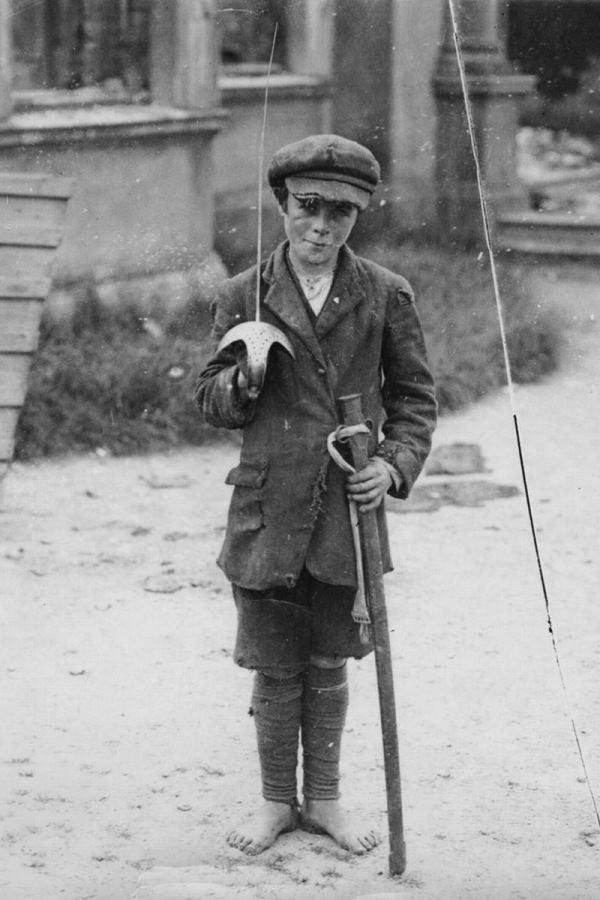
Independence Struggle: Anglo-Irish War (1919-22)

Figure 1.-- The photo was taken in Cork during the Anglo-Irish War which was mutating into the Irish Civil War (1922). No other information is available anout the boy here. Cork in the southeast of Ireland encapsulates Irish history. It began a sa mionastic settklement taken over by Vikings. The city charter was granted by Prince John before becoming king. It was a fully walled Medieval city. It supported the Yorkist cause in the War of the Rises. The city is sometimes referred to as the country's 'real capital' beause there was string oppostion to the Anglo-Irish Treaty which was the primary cause of the Irish Civil War.
|
|
The Anglo-Irish War or Irish War for Independence began on the day the Dáil first met. This was the alternative body in Dublin created by the Sinn Féin MPs elected in the 1918 General Election who to take their seats in Westminster. Irish resistance was centered in the Irish Republican Army (IRA) which begam assasinating British officials, British landlords, and their Irish supporters. IRA gunmen commanded by Dan Breen shot and killed two members of the Royal Irish Constabulary (RIC) in Tipperary--the Soloheadbeg ambush (January 21, 1919). The RIC supported British rule, but thecrank and file were Irish. The explosive shipment they were transporting was seized. This is seen as the beginning of the comflict because it was te day the Dáil met. The Soloheadbeg ambush was not the first killings. Shots were fired and people killed in 1918. The British managed to contain the violence for a while through aggressive, some might say oppresive, police work. The guerrila war which negan to achieve results was organized by the Volunteers or IRA Director of Intelligence, Michael Collins. He organized a ‘Squad’ to assassinate the British detectives who began arresting republican activists. Collins and his men even tried to kill John French, the Lord Lieutenant of Ireland, but failed. The violence was fairly limited in 1919, but various passive resistance actions were organized to promote the idea of independence and to make it difficult for the British to govern Ireland. Prisoners held by the British staged hunger strikes. The British released many (March 1920). Rail workers refused to transport troops. Disturbances proliferated n rural areas beyond the ares controlled by the British. Landless farm workers began to seize plots on large estates often called ‘ranches’. The British responded by arresting the Sinn Fein political leadership. Eamon de Valera, the President of the Republic, fled to America to raise funds. Violence increased notably (1920). The two principal IRA leaders, Collins and Richard Mulcahy, ordered Volunteer units to raid RIC barracks for arms. The Dáil eventually endorsed the IRA’s campaign of violence (1921). Sinn Fein figures, such as Arthur Griffith, opposed the violence. The IRA focused on small rural police barracks (early-1920). These were targets that small IRA groups could overcome and also haf the impact of lessing the British control of the countryside. The RIC was forced to withdrew from its small rural stations into fortified barracks in towns. The IRA organizing a burning oif these stations on the night of Easter Sunday 1920, of course to commemorate the 1916 Easter Rising. Their lives threatened, RIC men whio were Irish not British began resigning their commissions (Summer 1920). As aesult, the IRA gradually began to gakin cokntrol of rural areas. The RIC began responding in kind by assassing known republicans such as Tomas MacCurtain, the Lord mayor of Cork. Sinn Fein had won the 1918 General Election, meaning MPs. Sinn Fein won local government elections across most of Catholic Ireland (summer 1920). As aesult, they began taking over government funcions from the British, mot importantly tax collection and the police. In many areas the RIC was replaced by IRA police and the British judicial system by the Sinn Fein or Dáil Courts. The British Government responded by proposing autonomous governments in Northern and Southern Ireland. And to reverse the deterioirating security situation, the British introduced a new corps of paramilitary police recruited in Britain--the Black and Tans and Auxiliary Division. They werecrecruitedcfrom World War I veterans. Lloyd George oversaw the passge thriufg Parlamebt of the Restoration of Order in Ireland Act whch gave special powers to the police and military. The resuktv ws an escalation of violence. ate.
Sources
CIH

Navigate the Children in History Website:
[Return to Main Irish independence struggle page]
[Return to Main Irish history page]
[Return to Main 20th century war page]
[About Us]
[Introduction]
[Animals]
[Biographies]
[Chronology]
[Climatology]
[Clothing]
[Disease and Health]
[Economics]
[Ethnicity]
[Geography]
[History]
[Human Nature]
[Law]
[Nationalism]
[Presidents]
[Religion]
[Royalty]
[Science]
[Social Class]
[Bibliographies]
[Contributions]
[FAQs]
[Glossaries]
[Images]
[Links]
[Registration]
[Tools]
[Children in History Home]
Created: 9:56 AM 5/26/2019
Last updated: 9:56 AM 5/26/2019



